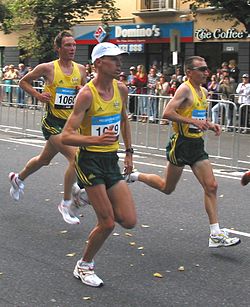- Gait (human)
-
- This article is about the physical exercise. For other uses, see here.
Human gait is the way locomotion is achieved using human limbs. Different gaits are characterized by differences in limb movement patterns, overall velocity, forces, kinetic and potential energy cycles, and changes in the contact with the surface (ground, floor, etc.).
Contents
Foot strike
One variable in different gaits is foot strike – how the foot contacts the ground, specifically which part of the foot first contacts the ground.
- forefoot strike – toe-heel: ball of foot lands first
- midfoot strike – heel and ball land simultaneously
- heel strike – heel-toe: heel of foot lands, then pronates to ball
In sprinting, gait typically features a forefoot strike, but the heel does not contact the ground.
Some researchers classify foot strikes by the initial center of pressure; this is mostly applicable to shod running (running while wearing shoes).[1] In this classification:
- a rearfoot strike (heel strike) has the initial center of pressure in the rear third of the shoe (0–33% of shoe length);
- a midfoot strike is in the middle third (34–67% of shoe length);
- a forefoot strike is in the front third (68–100% of shoe length).
Foot strike varies to some degree between strides, and between individuals. It varies significantly and notably between walking and running, and between wearing shoes (shod) and not wearing shoes (barefoot).
Typically, barefoot walking features heel or midfoot strike, while barefoot running features midfoot or forefoot strike. Barefoot running rarely features heel strike, because the impact is painful, the human heel pad not absorbing much of the force of impact.[2][3]
By contrast, 75% of runners wearing modern running shoes heel strike;[4][5] running shoes being characterized by a padded sole, stiff soles and arch support, and sloping down from a more padded heel to a less padded forefoot.
The cause of this change in gait in shod running is unknown, but Liebermann notes that there is correlation between the foot-landing style and exposure to shoes[5]. In some individuals the gait is largely unchanged – the leg position and foot position are identical in barefoot and shod running – but the wedge shape of the padding moving the point of impact back from the forefoot to the midfoot.[1] In other cases it is conjectured that the padding of the heel softens the impact and resulting in runner modifying their gait to contact further back in the foot.[5]
Whether this change in gait has health effects is unknown, and as of 2010 no studies exist demonstrating whether forefoot striking or heel striking is associated with higher injury rate. It is hypothesized that the impact of heel strikes is a cause of the high rates of repetitive stress injuries in shod runners, but has not been studied.[5]
Gender differences
There are gender differences in human gait: females walk with lesser step width and more pelvic movement.[6] Gait analysis generally takes gender into consideration.[7] Females walking with hip sway, and males walking with swagger in shoulder generally have more physical attractiveness.[8] A study by Stuart Brody of the University of the West of Scotland says female gait reflects orgasmic ability.[9] Gender differences in human gait can be explored using a demonstration created by the Biomotion Laboratory at Queen's University, Kingston, Canada. BMLWalker
See also
- Astasia abasia
- Contrapposto
- Gait abnormality
- Gait Abnormality Rating Scale
- Gait analysis
- Human positions
- Marche a petit pas
- Ministry of Silly Walks
- Power walking
- Terrestrial locomotion in animals
References
- ^ a b Running Before the Modern Running Shoe
- ^ Ker et al., 1995
- ^ Chi and Schmitt, 2005, J Biomech. 2005 Jul;38(7):1387-95. Epub 2004 Nov 30., Mechanical energy and effective foot mass during impact loading of walking and running., Department of Biology, Duke University
- ^ Foot Strike Patterns of Runners At the 15-Km Point : The Journal of Strength & Conditioning Research (Hasegawa et al., 2007).
- ^ a b c d Modern Running Shoes & Heel Striking, Daniel Lieberman, Harvard University
- ^ Gender differences in three dimensional gait analysis data from 98 healthy Korean adults, Clinical Biomechanics. doi:10.1016/j.clinbiomech.2003.10.003
- ^ BMLWalker V1.8, The Biomotion Lab. Gait animation.
- ^ Clues To Mysteries Of Physical Attractiveness Revealed, Science Daily, May 24, 2007
- ^ Gait may be associated with orgasmic ability, Eureka! Science News, September 4, 2008
Further reading
- "The biomechanics of skipping gaits: a third locomotion paradigm?" A E Minetti Proc Biol Sci. 1998 July 7; 265(1402): 1227–1235.
Animal locomotion on land Gait class LeggedBrachiation · Arboreal locomotion · Hand-walking · Jumping · Knuckle-walking · Gait · Running · WalkingLeglessConcertina movement · Undulatory locomotion · Rectilinear locomotion · Rolling · Sidewinding · Other modesAnatomy Comparative foot morphology · Digitigrade · Plantigrade · Ungulate · Uniped · Biped · Triped · Quadruped · Facultative bipedSpecific Categories:- Human skills
- Locomotion
- Walking
Wikimedia Foundation. 2010.

